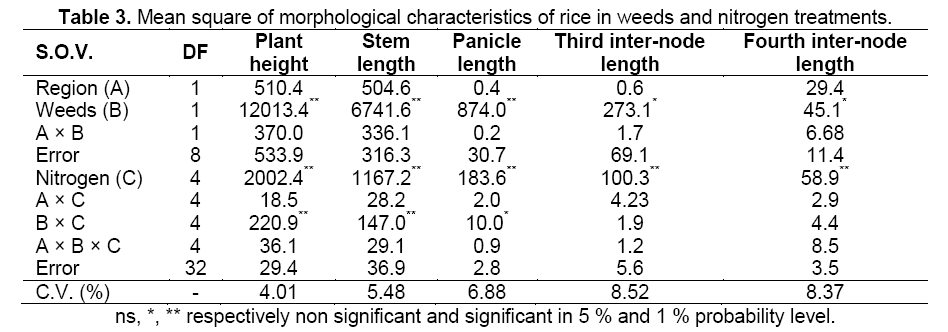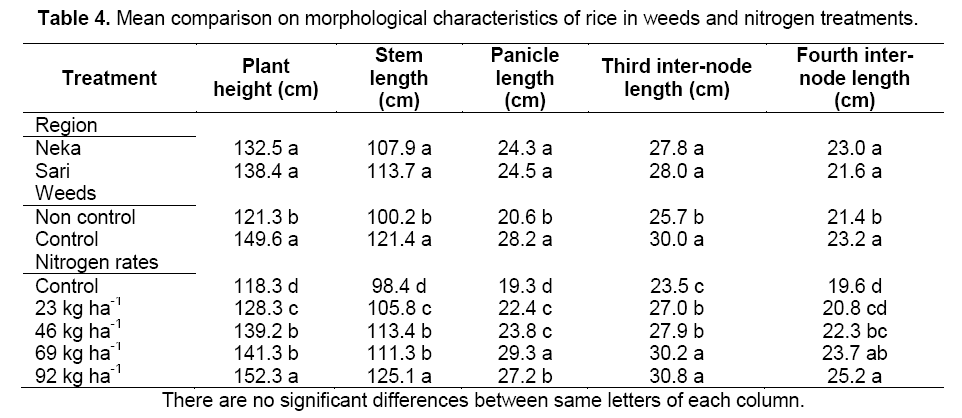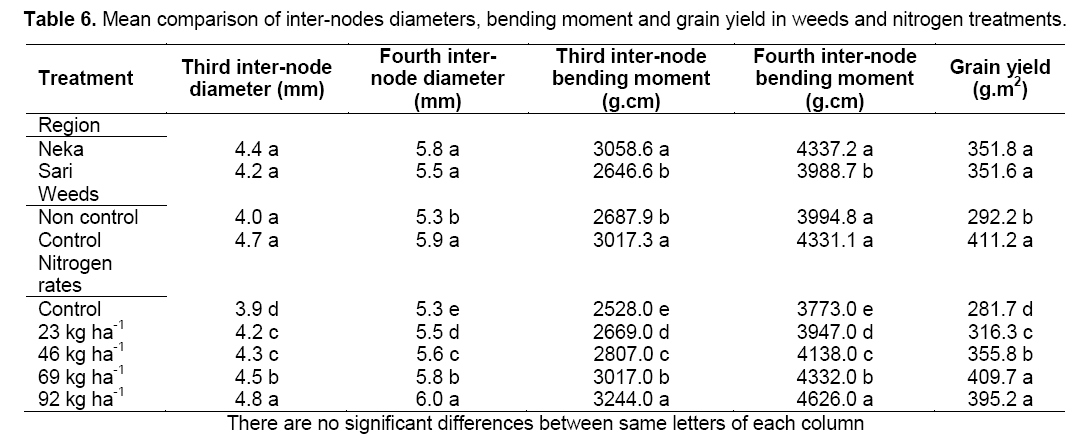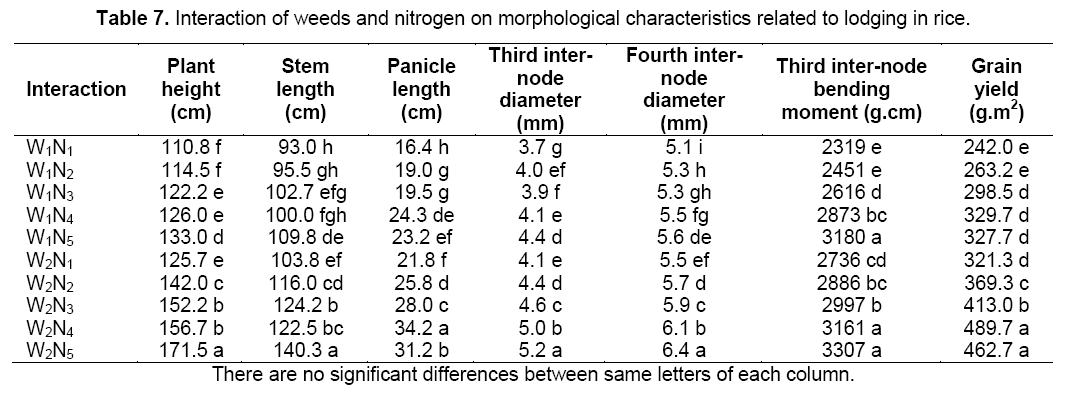Effects of Weeds Control and Nitrogen Application on Weeds and Rice Characteristics in Iranian Paddy Field
H. Jafari, S. Dastan, M.R. Moshtaghian, H.R. Eslami Rostami, B. Mohammadi, L. Valaei
H. Jafari1,S. Dastan2,*,M.R. Moshtaghian3,H.R. Eslami Rostami4,B. Mohammadi5,L. Valaei5
1Department of Agronomy,Takestan Branch,Islamic Azad University,Takestan,Iran
2Department of Agricultural Science,Payame Noor University,Iran
3Department of Agronomy,Khorram Abad Branch,Islamic Azad University,Khorram Abad,Iran
4Department of Forest Science,Chalous Branch,Islamic Azad University,Chalous,Iran
5Department of Agronomy,Qaemshahr Branch,Islamic Azad University,Qaemshahr,Iran
6Department of Agronomy,Varamin Branch,Islamic Azad University,Varamin,Iran
Abstract
This experiment was carried out in two fields in two areas in 2010. One of the fields was located at Neka town with 5 meter s above sea level and other one was at sari city with 905 meters above sea level. Weeds treatment (control and without control) was chosen as main factor and nitrogen treatment (0, 23, 46, 69, 92 kg h-1) as sub-factor. Results showed that bending moment 3rd and 4th inter-nodes at Neka town area (15.56 and 8.74 %) was more than sari city area respectively. With weeds control increased grain yield (40.73 %) because of less inter-specific competition and increase panicle length. Maximum grain yield was obtained for nitrogen treatment (69 and 92 kg h-1) because of increase in panicle length. Bending moment 3rd and 4th inter-nodes (28.32 and 22.61 %) increased in nitrogen treatment (92 kg h-1) over control because of increase in plant height, stem length, 3rd and 4th inter-nodes length and 3rd and 4th inter-nodes diameter. Minimum and maximum height, number and weeds dry weight were for control and nitrogen treatment (92 kg h-1) respectively. Weeds control treatment and nitrogen treatments (69 and 92 kg h-1) were best treatments because of increase in grain yield.
Keywords
Grain yield,Location,Nitrogen,Rice,Weed.
1. Introduction
Early weeding isn’t necessary because there is no competition between weeds and rice [1]. With progress of the growing season weeds make maximum damage to the plant [2]. All weeds remove before seedling transplanting,so there is no competition between weeds and rice in transplanting stage because there are few weeds and abundance of nutritional resources [3]. In tillering time crop growth is impaired with increasing of weeds and despite its not significant decrease of yield but if weeds don’t control it can significantly
decrease yield [4]. Weed interference with plant is important in tillering time and a good management Gives priority to weeding and weeds control [5]. Rice yield strongly decrease with delay in weeds control 15 to 25 days after transplanting in rice field and decrease of rice yield are 30 to 40 % in transplanting seedling and 70 to 80 % in directly sowing because of weeds competition [6]. Estorninos et al. (2005) found that number of tiller decreased from 20 to 48 % with increase of weeds density from 25 to 51 plants per m2 [7]. Nitrogen is important factor of growth limitation and lack of that caused decrease yield in each stage [8]. Nitrogen application in middle of growth stages increase grain yield,nitrogen absorption and nitrogen use efficiency [9]. No nitrogen application in tillering time caused to decrease plant height and increased panicle number per m2 and in heading cause to decrease 1000-seed weight,bending moment and s panicle number per m2 [10]. Samdaliri et al. (2011) stated that use of nitrogen (50 %) in planting time increase tiller number per m2 and use of one third nitrogen in heading time increase percentage of filled spikelet per panicle,also maximum grain yield was obtained with use of equal amount nitrogen in planting time,tillering time,panicle initiation and heading time [11]. Singh et al. (2002) were shown that with use of nitrogen (120 kg h-1) in three times (planting time,middle of tillering and panicle initiation) with equal amount increased panicle number per m2,spikelet number,percentage of filled spikelet and 1000-seed weight [12]. Belder et al. (2005) considered use of different levels nitrogen and the results showed grain yield increased with increasing nitrogen amount [13]. The purpose of this experiment was consider effects of weeds control and without control,nitrogen function on weeds,characteristics related to lodging and rice grain yield.
2. Materials and Methods
In order to consider effects of weeds control and without control,nitrogen function on weeds,characteristics related to lodging and rice (Oryza sativa) grain yield in two areas,an experiment was carried out in 2010 in two fields one was located at Neka town geographically situated at 36°,41' N latitude and 52°,3' E longitude at an altitude of 5 m above mean sea level and the other one was located at Sari city geographically situated at 36°,7' N latitude and 53°,55' E longitude at an altitude of 905 m above mean sea level. The soils of fields were clay-loam. The results of soil analyses are shown in Table 1 and the weather conditions in growth season are shown in Table 2.


The experimental work was started in April 2010. Seeds of rice var. Sang Tarom were procured from Rice Research Institute,Amol,Mazandaran,Iran. This experiment was done as split plot in randomized complete blocks design based 3 replications. Weeds treatment was chosen as main factor (control and without control) and nitrogen application as sub-factor (0,23,46,69 and 92 kg h-1). The field was ploughed with tractor drawn disc plough followed by a through harrowing to break the clods. The field was properly levelled and 5 × 2 m size plots were earmarked with raised bunds all around to minimize the moment of watering and nitrogen. Channels were laid to facilitate irrigation to plots individually and each replication had 10 plots. Before transplanting phosphorous and potassium (111 and 46 kg h-1) were scattered respectively. When rice seedlings were of 20 to 25 cm in height and 4 weeks old; they were uprooted and transplanted to experimental plots with 25 seedlings per m-2. Nitrogen application and weeds control were done by design map. All operations like plant illnesses controlling and pests controlling were done during the growth process with chemical components. During the growth time,following characteristics was measured randomly from each plot. Plant height and stem length were measured from 12 hills in middle of each plot. Panicle length and flag leaf length were measured in the middle of each plot. Grain yield was harvested from 4 M² from the middle of the plot with 14 % humidity. Internodes number and length of 3rd and 4th inter-nodes were numbered from 12 hills in middle of each plot. Diameters of 3rd and 4th inter-nodes (mm) were measured by Caliper from 12 stems in 4 hills per plot [14]. Bending moment of 3rd and 4th inter-nodes was measured from 12 stems in 4 hills per plot. Bending moment of 4th inter-node (g cm) = length of the plant from the lowest node of 4th inter-node up to the panicle × the wet weight of the same part [14]. Data analyzed by MSTAT-C statistical software and Averages comparison were calculated by Duncan’s multiple range tests in a 5% probability level.
3. Results
3.1 Crop parameters
Plant height had significant effect under weeds treatment,nitrogen amounts and interaction weeds × nitrogen in 1% probability level (Table 3). Plant height increased 23.33 % by weeds control and plant height was obtained (121.30 and 149.60 cm) for weeds without control treatment and control treatment respectively. Also plant height increased by nitrogen application (28.74 %),so minimum plant height (118.30 cm) was observed for control (0 kg h-1 nitrogen) and maximum of that (152.30 cm) was for (92 kg h-1) nitrogen treatment (Table 4).


According to Table 3,stem length had significant effect under weeds treatment,nitrogen amounts and interaction weeds × nitrogen in 1% probability level (Table 3). Stem length increased 21.16 % by weeds control and stem length was obtained (100.20 and 121.40 cm) for weeds without control treatment and control treatment respectively. Also stem length increased by nitrogen application (27.11 %),so that minimum stem length (98.42 cm) was observed for control (0 kg h-1 nitrogen) and maximum of that (125.10 cm) was for (92 kg h-1) nitrogen treatment (Table 4).
Panicle length had significant effect under weeds treatment,nitrogen amounts in 1 % probability level and interaction weeds × nitrogen in 5 % probability level (Table 3). Panicle length (20.57 and 28.20 cm) was for weeds without control treatment and weeds control treatment respectively and panicle length increased 37.09 % by weeds control treatment. Minimum panicle length (19.33 cm) was observed for control (0 kg h-1 nitrogen) and maximum of that (29.25 cm) was for (69 kg h-1) nitrogen treatment (Table 4).
Length of 3rd inter-node had significant effect under weeds treatment in 5 % probability level and under nitrogen amounts in 1 % probability level (Table 3). Length of 3rd inter-node increased 16.60 % by weeds control treatment that they were 25.73 and 30.00 cm for without weeds control and weeds control treatments respectively. Also length of 3rd inter-node increased 30.85 % by nitrogen application. Length of 3rd inter-node 23.50,27.00,27.92,30.17 and 30.75 cm was obtained by nitrogen application 0,23,46,69 and 92 kg h-1 respectively (Table 4).
Length of 4th inter-node had significant effect under weeds treatment and interaction planting area × weeds × nitrogen in 5 % probability level and under nitrogen amounts in 1 % probability level (Table 3). Length of 4th inter-node was 21.43 and 23.17 cm for without weeds control and weeds control treatments respectively. Also length of 4th inter-node increased 28.55 % by nitrogen application. Length of 4th inter-node 19.58,20.83,22.25,23.67 and 25.17 cm was obtained by nitrogen application 0,23,46,69 and 92 kg h-1 respectively (Table 4).
Diameter of 3rd inter-node had significant effect under nitrogen amounts and interaction weeds × nitrogen in 1 % probability level (Table 5). Diameter of 3rd inter-node increased 23.08 % with nitrogen application (92 kg h-1) compare to control (0 kg h-1 nitrogen). Diameter of 3rd inter-node 3.90,4.20,4.27,4.53 and 4.80 mm was obtained by nitrogen application 0,23,46,69 and 92 kg h-1 respectively (Table 6).


Diameter of 4th inter-node had significant effect under weeds,nitrogen in 1 % probability level and interaction weeds × nitrogen in 5 % probability level (Table 5). Diameter of 4th inter-node increased 11.24 % with weeds control compare to weeds without control treatment. Diameter of 4th inter-node increased 13.99 % with nitrogen application (92 kg h-1) compare to control (0 kg h-1 nitrogen) (Table 6). Bending moment of 3rd inter-node had significant effect under planting area,weeds,nitrogen in 1 % probability level and interaction weeds × nitrogen in 5 % probability level (Table 5). Bending moment of 3rd inter-node in Neka town area (3058.60 g cm) was more than Sari city area (2646.60 g cm). Bending moment of 3rd inter-node in weeds without control treatment (2687.90 g cm) was less than weeds control treatment (3017.30 g cm) because of being lower 3rd and 4th inter-nodes ,flag leaf length,panicle,stem,plant height and reduce diameter 4th inter-node. Bending moment of 3rd inter-node increased 28.32 % with nitrogen application (92 kg h-1) compare to control (0 kg h-1 nitrogen). Bending moment of 3rd inter-node 2528,2669,2807,3017 and 3244 g cm was obtained by nitrogen application 0,23,46,69 and 92 kg h-1 respectively (Table 6).
Bending moment of 4th inter-node had significant effect under planting area in 5 % probability level and nitrogen amount in 5 % probability level (Table 5). Bending moment of 4th inter-node in Neka town area (4337.20 g cm) was more than Sari city area (3988.70 g cm). Bending moment of 4th inter-node increased 22.61 % with nitrogen application (92 kg h-1) compare to control (0 kg h-1 nitrogen),so that bending moment of 4th inter-node 3773,3947,4138,4332 and 4626 g cm was obtained by nitrogen application 0,23,46,69 and 92 kg h-1 respectively (Table 6).
Grain yield had significant effect under weeds treatment,nitrogen amounts and interaction weeds × nitrogen in 5 % probability level (Table 5). Grain yield by weeds control treatment (411.20 g m2) increased 40.73 % because of panicle length increase and decrease in lodging characteristic compare to weeds without control (292.20 g m2). Minimum grain yield (281.70 g m2) was noted for control (0 kg h1 nitrogen) because of reduce in panicle length and maximum of that (409.70 g m2) was for 69 kg h1 nitrogen (Table 6).
Interaction showed that the maximum panicle length (34.17 cm) was conducted for interaction weeds control × nitrogen (69 kg h-1) and minimum of that (16.83 cm) was for interaction weeds without control × control (without nitrogen application). The most stem length (140.30 cm) was conducted for interaction weeds control × nitrogen (92 kg h-1) and minimum of that (93.00 cm) was for interaction weeds without control × control (without nitrogen application). The maximum plant height (171.50 cm) was conducted for interaction weeds control × nitrogen (92 kg h-1) and minimum of that (110.80 cm) was for interaction weeds without control × control (without nitrogen application). The most inter-node length (28.33 cm) was noted for interaction Sari city area × weeds control × nitrogen (92 kg h-1) and minimum of that (17.67 cm) was for interaction Neka town × weeds without control × control (0 kg h-1 nitrogen) (Table 7). The maximum diameter of 4th inter-node (6.42 mm) was noted for interaction weeds control × nitrogen (92 kg h-1) and minimum of that (5.05 mm) was for interaction weeds without control × (control) 0 kg h-1 nitrogen. Maximum diameter of 3rd inter-node (5.23 mm) was noted for interaction weeds control × nitrogen (92 kg h-1) and minimum of that (3.73 mm) was for interaction weeds without control × (control) 0 kg h-1 nitrogen. The maximum bending moment of 3rd inter-node (3180 g cm) was noted for interaction weeds without control × nitrogen (92 kg h-1) and minimum of that (2319 g cm) was for interaction weeds without control × (control) 0 kg h-1 nitrogen. Maximum grain yield (489.70 g cm) was noted for interaction weeds control × nitrogen (69 kg h-1) and minimum of that (242.00 g cm) was for interaction weeds without control × (control) 0 kg h-1 nitrogen (Table 7).

3.2 Weeds investigated characteristics:
Weeds were indentified in rice field,the most important and main weeds were barnyard grass (Echinochloa crus-galli L.) and Rice flat sedge (Cyperus iria L.) because those were higher and more than the others and occupied widely ecological nich. Weeds height had significant effect under planting area in 5 % probability level and nitrogen in 1 % probability level (Table 8). Weeds height in Sari area (67.4 cm) was more than Neka area (39.8 cm). Weeds height by 92 kg h1 nitrogen treatment (69.67 cm) increased 30.92 % compare to control (0 kg h1) 30.17 cm (Table 9). Weeds number per m2 had significant effect under nitrogen treatment in 1 % probability level (Table 8). Maximum (47.17) and minimum (15.17) of weeds number were noted for 92 kg h1 nitrogen and control treatment (0 kg h1 nitrogen) respectively (Table 9). Weeds dry matter per m2 had significant effect under planting area in 5 % probability level and nitrogen in 1 % probability level (Table 10). Weeds dry matter per m2 in Sari area (252.10g m2) was more than Neka area (113.70 g m2). Maximum weeds dry matter (239.00 g m2) was observed for 92 kg h1 nitrogen and minimum of that (121.70 g m2) was for control (0 kg h1 nitrogen) (Table 9) .


4 Discussions and Conclusions
Islam et al. (2003) have seen plant height was 76.5 cm when there was no competition between rice and weeds but in 112 plants per m2 barnyard grass decreased 42.9 % plant height [15],this results were supported by [16]. Asghari (2002) stated that plant height increased by weeds control and less nutritional competition [17]. Sadati and Fallah (1995) stated that plant height had significant different in tillering time by nitrogen contributing in 1 % probability level [18].
Panicle length (17.21 %) increased by weeds control. Panicle length in transplanting rice and direct sowing rice effects in grain yield by more transfer of photosynthetic material [21]. Sadati and Fallah (1995) found that panicle length had significant different in tillering time by nitrogen contributing in 1 % probability level [18]. Inter-node length decreased by nitrogen application less than 40 kg h-1 [21]. Lengths of 3rd and 4th inter-nodes are more important as morphological characteristics because most of rice lodging happens in two inter-nodes [15].
Yoshida (1981) stated that Inter-node length decreased by nitrogen application less than 40 kg h-1 [21]. Lengths of 3rd and 4th inter-nodes are more important as morphological characteristics because most of rice lodging happens in two inter-nodes,on the other hand lengths of 3rd and 4th inter-nodes had positive correlation with lodging index [15].
Rice grain yield decreased with barnyard grass competition because it reduced fertile tiller number,spikelet number per panicle and 1000-seed weight [16]. Grain yield decreased 25 % by weeds competition [22]. Reduce of dry matter gathering was for competition between rice and weeds for nutrition sources and light [23]. Researchers reported reduce of dry matter gathering by competition conditions [8,16,24]. Grain yield increased by more nitrogen application [23]. Grain yield strongly decreased by delay in weeds control in rice filed and reduce of grain yield was 30 to 40 % for transplanting rice and 70 to 80 % in seedling direct planting [6]. Grain yield increased by contributing 120kg h1 nitrogen in same amount and three stages (before transplanting,tillering time and panicle initiation) [12]. Between nitrogen contributing treatments had no significant different [25] that it is inconsistent with our results. Barnyard grass is so important between rice weeds because of similarity in genetically,morphological and phenotype [26]. Also barnyard grass had C4 Photosynthetic pathway and more carbon exchanging capacity compare to rice (C3),so it had more efficient in water absorption and nitrogen [27].
There is no competition between rice and weeds in early growth stage and weeding is not necessary [1]. Weeds had the most damage in crops when it reached to sources limitation time [2]. Natural process of rice growth was disturbed by increase of weeds seed germination and occupied within the row space [4].
Inter-specific competition decreased by weeds control between weeds and rice consequently rice plant had proper nutrition and enough space for optimal growth,so grain yield increased 40.73 % by weeds control compare to weeds without control. Bending moment 3rd and 4th inter-nodes increased for four reasons: increase of plant height,stem length,4th inter-node length,3rd and 4th inter-nodes diameters with 92 kg h1 nitrogen application. Maximum and minimum of weeds height,weeds number and weeds dry matter were observed by 92 kg h1 nitrogen and control (0 kg h1 nitrogen) respectively.
References
- Hall M.R.,Swanton C.J.,Anderson G.W.,(1992) The critical period of weed control in grain corn (Zea mays L.). Weed Science,40: 441-447.
- Wilson H.P.,and Cole R.H.,(1966) Morningglory competition in soybean (Glycin max L.). Weed Science,14: 49-51.
- Radosevich S.R.,(1987) Methodes to study interactions among crops and weeds. Weed Technology,1: 190-198.
- Rejmanek M.,Robinson G.R.,Rejmankova E.,(1989) Weed crop competition: Experimental designs and methods for data analysis. Weed Science,37: 267-274.
- Van-Acker R.C.,Successes C.G.,Weise S.F.,(1993) The critical period of weed control in soybean (Glycine max L.). Weed Science,41: 194-200.
- Balasubramaniyam P.,Palaniappans P.,(2002) Principles and practices of agronomy. Agrobioses,Todhpur printed HS offset New Delhi.
- Estorninos L.E.,Geoly D.R.,Gbur E.E.,(2005) Rice and red rice interference. Rice response to population dersities of three red rice ecotypes. Weed Science,53: 683-689.
- Haefel S.M.,Naklang K.,Harnpichitvitaya D.,et al. (2006) Factor affecting rice yield and fertilizer response in rain fed lowlands of northeast Thailand. Field Crop Research,98: 39- 51.
- Zheng L.,Shanon M.C.,(2000) Effect of salinity on grain yield and yield components of rice at different seedling densities. Agronomy Journal,92: 418-423.
- Akhavan M.,Samdaliri M.,Mobasser H. R.,et al. (2009) Effect of no nitrogen and planting density on rice agronomical characteristics langroudi tarom cultivar. Journal of Research in Agronomical Science,5(2):37-45.
- Samdaliri M.,Mobasser,H. R.,Dastan S.,(2011) Effect of amount and contributing nitrogen on physiological and agronomical characters in local tarom variety. Journal of Research Science in Eco-physiological Crops,3(1):101-109.
- Singh B.Y.,Ladha,J.K.,Bronson K.F.,et al. (2002) Chlorophyll-meter and leaf color chart-based nitrogen management for rice and wheat in northwestern India. Agronomy Journal,94: 821- 829.
- Belder P.,Spiertz,J.H.J.,Bouman B.A.M.,et al. (2005) Nitrogen economy and water productivity of lowland rice under water irrigation. Field Crop Research,93: 169-185.
- Islam F.,Rezaul-Karim S.M.,Hague S.M.A.,et al. (2003) Effects of population density of Echinochloa crusgalli,Echinochloa coconum on rice Pakistan. Agronomy Journal,2(3): 120-125.
- Islam M.S.,Peng Sh.,Visperas R.M.,et al. (2007) Loding-related morphological traits of hybrid rice in a tropical irrigated ecosystem. Field Crops Research,104(2): 240-248.
- Holm L.G.,Pancho J.V.,Herberger J.P.,et al. (1977) The world's worst weeds; University Press of Hawaii: Honolulu.
- Asghari J.,(2002) The critical period of weed control in two cultivars of rice (Oryza sativa L.) In drought stress condition. Journal of Agricultural Science,37(4); 1-12.
- Sadati N.,Fallah A.,(2005) Consider of effective factors in rice ratoon grain yield tarom cultivar. National Rice Research Inistitute,Amol.
- Malek M. R.,Mobasser,H.R.,Delkhosh B.,(2011) Investigation effect of crop residue treatment and spaces within rows on agronomical characteristics on rice local tarom cultivar. First congress of sciences and new technologies in agriculture. Zanjan University.
- Dobermann A.C.D.,Witt D.,Dawe S.,et al. (2002) Site-specific nutrient management for intensive rice cropping system in Asia. Field Crop Research,74: 37-66.
- Yoshida,S.,1981. Fundamentals of rice. International Rice Research Institute,Los Banos. Philippines. 94- 110.

Open Access Journals
- Aquaculture & Veterinary Science
- Chemistry & Chemical Sciences
- Clinical Sciences
- Engineering
- General Science
- Genetics & Molecular Biology
- Health Care & Nursing
- Immunology & Microbiology
- Materials Science
- Mathematics & Physics
- Medical Sciences
- Neurology & Psychiatry
- Oncology & Cancer Science
- Pharmaceutical Sciences
